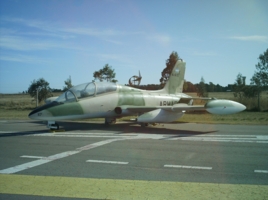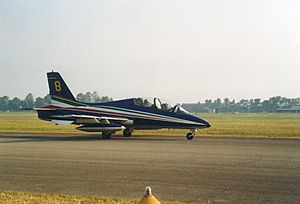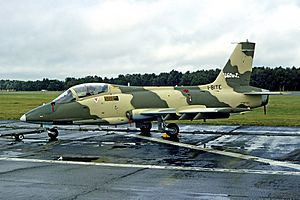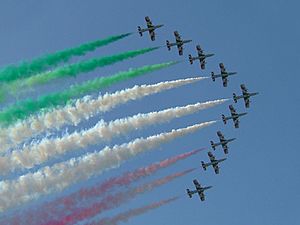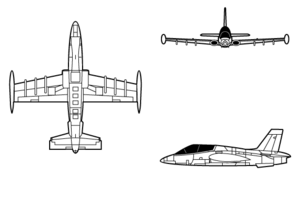Aermacchi MB-339 facts for kids
class="infobox " style="float: right; clear: right; width: 315px; border-spacing: 2px; text-align: left; font-size: 90%;" ! colspan="2" style="text-align: center; font-size: large; padding-bottom: 0.3em;" | MB-339 |-
|- | colspan="2" style="text-align: center;" |  |- |colspan="2" style="border-bottom: 1px solid #aaa;text-align:center;" |An MB-339CD of the Italian Air Force |-
|- |colspan="2" style="border-bottom: 1px solid #aaa;text-align:center;" |An MB-339CD of the Italian Air Force |-
! Role | Advanced trainer and light attack aircraft |-
! Manufacturer | Aermacchi |-
! First flight | 12 August 1976 |-
! Introduction | 1979 |-
! Status | Active in production |- ! Primary users | Italian Air Force
Royal Malaysian Air Force
Eritrean Air Force
United Arab Emirates Air Force |- ! Produced | 1978–TBD |- ! Number built | 230 |-
! Unit cost | $7 million (2003) |- ! Developed from | Aermacchi MB-326 |-
|} The Aermacchi MB-339 is a military jet trainer and light attack aircraft made by the Italian company Aermacchi.
This aircraft was created in the 1970s. The Italian Air Force needed a new plane to replace their older Aermacchi MB-326s. Instead of designing a completely new plane, Aermacchi decided to improve the MB-326. This made the MB-339 similar to its older cousin. Aermacchi found that the MB-339 could do everything the Air Force wanted, and it was also the cheapest option.
The first MB-339 flew on August 12, 1976. The first planes were delivered to customers two years later. About half of all MB-339s went to the Italian Air Force. The rest were sold to other countries. Besides being used for training, the MB-339 is also flown by the Frecce Tricolori aerobatic display team.
The plane has been used in real battles. The Eritrean Air Force used it during the Eritrean–Ethiopian War (1998–2000). The Argentine Naval Aviation also used it during the Falklands War in 1982. In both wars, the MB-339 was mostly used to attack targets on the ground. The Italian Air Force plans to replace their MB-339s with a newer plane called the Aermacchi M-345.
Contents
How the MB-339 Was Developed
In 1972, Aermacchi was asked to study a new plane for the Italian Air Force. They needed to replace their old Aermacchi MB-326 planes, which were used for advanced jet training. Aermacchi looked at seven new designs. They also looked at an improved version of the MB-326, which they called the MB-339.
They found that the MB-339 could meet all the Air Force's needs. It was also cheaper than building a completely new plane. So, the MB-339 was chosen in 1975 to replace both the MB-326 and the Fiat G.91T planes in Italy.
The first test flight of the MB-339 happened on August 12, 1976. The first planes for customers flew in July 1978. Deliveries of the MB-339A to the Italian Air Force began in 1979. The Italian Air Force became the main user of this plane. Between 1978 and 1987, Italy received 101 MB-339As. This was almost half of all the planes built.
Aermacchi also made different improved versions. In 1980, a special single-seat attack version, called the MB-339K Veltro II, flew for the first time. In 1985, the MB-339B started flying. This version could also do light attacks. In the same year, the first MB-339C flew. This was a plane that could be used for both training and fighting.
Later, the improved MB-339C became available. This model had a much more modern cockpit. The Italian government decided to buy the MB-339CD. This version had a digital cockpit and a special probe for aerial refueling. This meant it could be used to train pilots for refueling in the air.
In the 1990s and 2000s, Italy continued to get more MB-339CD planes. Some other countries also updated their older MB-339s to the newer MB-339C standard. In 2006, Aermacchi announced they would start making the MB-339 again. This was because three different customers wanted to buy more of them.
How the MB-339 Is Designed
The Aermacchi MB-339 is a military jet trainer and light attack aircraft. It has a common design with two main wheels and a nose wheel (called tricycle gear). It is made completely of metal. It looks very similar to the older MB-326 because it uses most of the same parts.
One big change in the MB-339 was its front part. The instructor's seat was raised. This allowed the instructor to see over the student pilot's head. Usually, two people fly the plane. The student sits in the front, and the instructor sits behind and slightly above them. The cockpit is pressurized, meaning the air inside is kept at a comfortable pressure. It has a canopy that can be thrown off in an emergency. Both seats have Martin-Baker ejection seats, which can launch the pilots out safely.
The MB-339 has low, straight wings with fuel tanks at the tips. The air for the single turbojet engine goes into openings in the wing roots. The first versions of the plane used a Rolls-Royce Viper 632-43 engine. This engine could produce 4,000 pounds of thrust. This is the same engine used in the older MB-326K. Newer models, like the MB-339C, have a more powerful Viper 680 engine. This engine can produce up to 4,300 pounds of thrust. The MB-339 also has a larger tailfin than its older version. This helps with how the plane flies.
Some MB-339 models are mainly for training. Others are made for light fighter and fighter-bomber roles. The planes made for combat have more advanced electronics. These include better navigation systems, digital computers for attacks, and controls that let pilots use their hands on the throttle and stick (HOTAS). They also have defensive systems like radio jammers, radar warning receivers (RWR), and electronic countermeasures (ECM). These planes also have larger fuel tanks on the wingtips.
The MB-339K can carry two 30mm DEFA cannon. It also has six places under its wings where it can carry up to 1,815 kilograms (4,000 pounds) of weapons. It can carry different types of weapons, such as Sidewinder and R.550 Magic air-to-air missiles. It can also carry AGM-65 Maverick air-to-surface missiles, laser-guided bombs, rockets, and the Marte Mk.2 anti-ship missile.
MB-339 in Action
General Use
The Italian Air Force is the biggest user of the MB-339. They received their first planes in 1978 and have bought many different models over the years. For decades, it has been their main training aircraft.
Besides training, the MB-339 is also flown by the Frecce Tricolori aerobatic display team. In October 2013, Italy announced that they plan to replace their MB-339s with new M-345 planes. The M-345 will be used for basic training and by the Frecce Tricolori team.
Many countries, like the Royal New Zealand Air Force, bought the MB-339 in the 1980s and 1990s. They used it to replace their older jet attack planes. Some countries, like the United Arab Emirates, even use the MB-339 for aerobatic displays. Their team, Al Fursan, flies 7 MB-339A planes.
Combat Use
Argentina
The Argentine Naval Aviation was the first foreign user of an earlier Aermacchi plane, the MB-326GB. In 1980, they ordered ten MB-339A planes for advanced training and light attacks. These planes arrived in 1981.
During the Falklands War in April 1982, six MB-339s were at Port Stanley Airport. They were the only attack jets flying from the Falkland Islands. On May 3, 1982, Lieutenant Benitez crashed his plane while approaching the airport and died.
On May 21, an MB-339A flown by Lieutenant Owen Crippa attacked a British naval force. The plane hit the British ship HMS Argonaut, causing minor damage. On May 27, an MB-339A was shot down by a Blowpipe missile during the Battle for Goose Green. The pilot, Lieutenant Miguel, was killed. The British captured three MB-339 planes. One of them is now in a museum in England.
Eritrea
During problems between Eritrea and Ethiopia in the late 1990s, Eritrea started to rebuild its air force. In 1996, Eritrea ordered six Aermacchi MB-339CEs. These planes formed the first combat unit of the Eritrean Air Force in 1997. They were used for training and also in early fighting in 1998.
Their first combat mission was on June 5, 1998. On that day, Ethiopia reported two attacks by Eritrean MB-339FDs on the city of Mekelle. Sadly, many civilians were killed and injured. However, on June 6, one of the MB-339s was shot down north of Mekelle. The pilot ejected from the plane.
On June 12, 1998, four MB-339s attacked targets in the city of Adigrat. They used rockets and cluster-bombs. Ethiopian sources said that four people died and 30 were injured in these attacks. On February 5, 1999, Ethiopia claimed that two Eritrean MB-339FDs attacked a fuel storage area in Adigrat. This area was important for supplying fuel to the Ethiopian Army.
Different Versions (Variants)
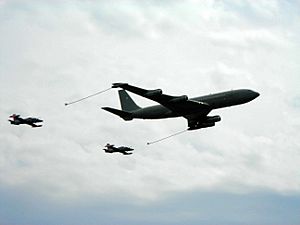
- MB-339X
- These were the three first test planes.
- MB-339A
- This was the first version made for Italy. 107 were delivered between 1979 and 1995. Four were also sent to Ghana and five to the UAE.
- MB-339PAN
-
- This version is for the Frecce Tricolori aerobatic team. It has a smoke generator but no wingtip fuel tanks. 21 were built or changed from the MB-339A.
- MB-339RM
- This version was for the Italian Air Force to test radios and radars. Three were built in 1981 but later changed back to MB-339A standard.
- MB-339AM
- This MB-339A version was built for Malaysia. 13 were delivered starting in 1983.
- MB-339AN
- This MB-339A version was built for Nigeria. Twelve were built starting in June 1984.
- MB-339AP
- This MB-339A version was built for Peru. Sixteen were built and delivered starting in November 1981.
- MB-339K Veltro II
- This was a single-seat version made only for attack. It first flew on May 30, 1980. Only one was built.
- MB-339B
- A trainer with a more powerful Viper 680-43 engine. Only one was built.
- MB-339C
- A changed trainer version with new digital electronics.
- MB-339CB
-
- This was a version of the MB-339C for New Zealand. It had a Viper 680-43 engine and could use AIM-9L Sidewinder and AGM-65 Maverick missiles. Eighteen were built and delivered starting in March 1991.
- MB-339CD
- This MB-339C version was for Italy. It had modern flight controls and electronics, but kept the original Viper 632-43 engine. 30 were built.
- MB-339FD ("Full Digital")
- This was an export version of the MB-339CD.
- MB-339CE
- This MB-339C version was built for Eritrea and had a Viper 680-43 engine. Six were built.
- MB-339CM
- This MB-339C version is being built for Malaysia.
- MB-339 T-Bird II (Lockheed T-Bird II)
- This version was made for a competition in the U.S. It had a Viper 680-582 engine.
Who Uses the MB-339 Now
 Eritrea
Eritrea
- Eritrean Air Force uses 5 MB-339CE planes.
 Italy
Italy
- Italian Air Force uses 72 MB-339A MLU, 30 MB-339CD, 21 MB-339PAN, and 3 MB-339RM planes.
 Malaysia
Malaysia
- Royal Malaysian Air Force uses 7 MB-339CM planes.
 United Arab Emirates
United Arab Emirates
- United Arab Emirates Air Force uses 10 MB-339NAT planes (including 4 that used to belong to Italy).
 United States of America
United States of America
- Draken International uses 9 MB-339CB planes that they bought from the Royal New Zealand Air Force.
Who Used the MB-339 Before
 Argentina
Argentina
- Argentine Naval Aviation had 10 planes, but stopped using them in the 1990s.
 Ghana
Ghana
- Ghana Air Force used 4 MB-339A planes.
 Peru
Peru
- Peruvian Air Force used 14 MB-339AP planes. They are now stored.
 New Zealand
New Zealand
- Royal New Zealand Air Force had 18 MB-339CB planes. They were used by No. 14 Squadron RNZAF between 1991 and 2002. Nine of these planes are now used by a private company in the United States.
 Nigeria
Nigeria
- Nigerian Air Force used 12 MB-339AN planes. They are now stored.
Facts About the MB-339A
Data from Jane's All The World's Aircraft 1980–81
General characteristics
- Crew: 2 pilots
- Length: [convert: invalid number]
- Wingspan: 10.86 m ([convert: unknown unit])*
- Height: [convert: invalid number]
- Wing area: 19.3 square[convert: unknown unit]
- Aspect ratio: 5.26:1
- Airfoil: root: NACA 64A-114 (mod); tip: NACA 64A-212 (mod)
- Empty weight: [convert: invalid number]
- Gross weight: 4,400 kilograms[convert: unknown unit] (clean)
- Max takeoff weight: 5,897 kilograms[convert: unknown unit] (with external stores)
- Fuel capacity: 1,413 L (311 imp gal; 373 US gal) internal fuel
- Powerplant: 1 × Rolls-Royce Viper Mk. 632 turbojet engine, 17.8 kN ([convert: unknown unit])* thrust
Performance
- Maximum speed: 898 km/h ([convert: unknown unit])* at sea level
- Stall speed: 148.5 km/h ([convert: unknown unit])*
- Never exceed speed: 926 km/h ([convert: unknown unit])* (EAS: Mach 0.82)
- Range: 1,760 km ([convert: unknown unit])* (internal fuel)
- Ferry range: 2,110 km ([convert: unknown unit])* (with two drop tanks)
- Service ceiling: 14,630 m ([convert: unknown unit])*
- g limits: +8.0, -4.0 (how much force it can handle)
- Rate of climb: [convert: unknown unit] (6,595 ft)*
Armament
- Guns: Can carry two 12.7 mm M2 Browning machine guns or two 30mm DEFA cannon in pods under the wings.
- Hardpoints: 6 (places to attach weapons) with a capacity of Up to 1,815 kg (4,001 lb) of weapons.,
- Rockets: Can carry pods for Zuni or SNEB unguided rockets.
- Missiles: Can carry AIM-9 Sidewinder or R.550 Magic air-to-air missiles.
- Bombs: Can carry general-purpose bombs.
See also
 In Spanish: Aermacchi MB-339 para niños
In Spanish: Aermacchi MB-339 para niños
- Aircraft related to this one
- Aermacchi MB-326
- Similar aircraft
- Aero L-39 Albatros
- Aero L-159 ALCA
- BAE Systems Hawk
- Dassault/Dornier Alpha Jet
- IAR 99
- Soko G-4 Super Galeb



